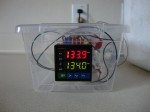 The Pogoplug E02 is a Linux-capable embedded computer with gigabit Ethernet and USB connectivity. It can be found quite cheap (US$35 or so) on the secondary market. As it was originally sold as a storage appliance for home users, it ships with somewhat inflexible factory firmware. However, it is reasonably easy to replace the bootloader with one which can boot an arbitrary Linux distribution.
The Pogoplug E02 is a Linux-capable embedded computer with gigabit Ethernet and USB connectivity. It can be found quite cheap (US$35 or so) on the secondary market. As it was originally sold as a storage appliance for home users, it ships with somewhat inflexible factory firmware. However, it is reasonably easy to replace the bootloader with one which can boot an arbitrary Linux distribution.
Once I got my Pogoplug running Debian, it was surprisingly easy to set it up as network storage using ATA-over-Ethernet. Details after the jump.





